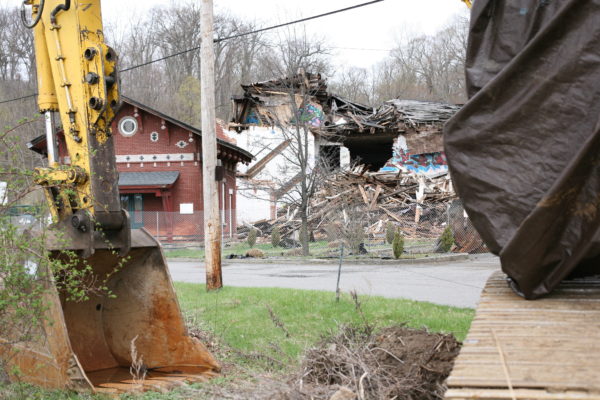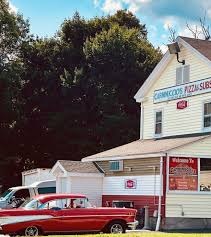A developer”™s recent move to demolish a national historic site on the Ossining riverfront has angered and alarmed village officials and history-minded residents, adding another incident to the contentious contemporary history of a deteriorating relic of Ossining”™s industrial past.
Village officials on April 14 issued a stop work order at 36 N. Water St., where brothers Peter and Nicholas Stolatis that day began razing the former Brandreth Pill Factory, a mid-19th century red-brick complex distinguished by its mansard-roofed architecture and as one of the first industrial manufacturing sites in Westchester County. Listed on the National Register of Historic Places, the main factory building on the roughly 5-acre property was stripped of its fa̤ade by wrecking equipment, leaving graffiti-covered walls on the buildingӪs upper and lower floors exposed amid rubble, before the work was halted.
The Stolatis brothers”™ Pleasantville company, Plateau Associates LLC, acquired the secluded property at a foreclosure auction in 2001, according to the developer”™s attorney and a village official. Vacant since 1979, the old factory has been a notorious partying spot for youths and hidden target for vandals.
For several years, Plateau Associates has been thwarted and delayed by village opponents and the economy in efforts to redevelop the property as Hidden Cove, a luxury residential development beside the Metro-North Railroad tracks. In 2011, the Stolatises returned to the village Planning Board with revised plans for a six-story, 137-unit apartment building on the site. Rather than restore and renovate the pill factory as condo loft space as they initially proposed, the developers planned to raze the building.
The village in 2008 had issued Plateau a demolition permit for the North Water Street property. Some critics of the planned development have claimed the owners have deliberately let the historic property fall further into structural collapse and disrepair to justify its demolition.
In the wake of Hurricane Sandy and updated floodplain mapping, Plateau Associates President Peter Stolatis in 2012 said the Hidden Cove development would have to be raised five to six feet on a pedestal, adding “tremendous costs” to a project he estimated in the mid-$50 million range and leaving the mill”™s first-floor space useless for residential conversion.
The owner”™s plans encountered another obstacle when the village Historic Preservation Commission in late 2012 notified Plateau that the Brandreth site was nominated for designation as a local landmark. That would protect the factory from demolition unless the developer could prove that restoring and reusing the historic property was not economically feasible.
The developerӪs planning consultant told the village commission that year that restoring the factory fa̤ade and roof by historic preservation standards and adding ground-floor flood barriers would cost $3.2 million. The restoration cost would exceed the propertyӪs value, the consultant said.
But the village commission went ahead and recommended the property be landmarked. The village Board of Trustees approved the historic designation two years ago, Ossining Mayor Victoria Gearity said.
Paul D. Stone, the Tarrytown attorney representing Plateau Associates, said Ossining officials in 2012 charged the developer with violations of the state Building Code at the crumbling property. The charges were dismissed and a state appeals court last year upheld their dismissal, Stone said.
But village officials this year resumed their effort to force the Stolatises to repair and maintain the historic site. They re-filed several charges of violations under the Village Code, citing leaky roofs and broken windows and doors.
At March appearances in Ossining town court, Plateau announced that it would go ahead with the building demolition “in order to cure any claimed violations,” Stone said. He cited a section of the village code that states: “Any owner of a building received a notice of violation stating that such building does not comply with the provisions of this chapter may demolish such building, and such action shall be deemed compliance.”
On March 31, the developer provided documents to the village Building Department that met all technical requirements for proceeding with the demolition, Stone claimed.
He said the village”™s reason for halting the work ”” that the owner lacked a demolition permit ”” “is an absolute untruth. We think the stop work order was improvidently issued.”
Gearity said the Stolatis brothers failed to meet seven requirements for the demolition permit, including a certificate of appropriateness from the Historic Preservation Commission and several standard practices. “This is not their first time at the rodeo,” she said. “They know the steps you need to go through.”
Gearity also claimed the 7-year-old demolition permit was no longer valid because the property must be in compliance with the building code at the time of demolition. She said the village”™s code enforcers continue to issue violation notices for the property “on an almost daily basis.”
Accessible only by a narrow private road, limited in redevelopment options by a steep ridge and protected as a national historic place, “This property is just fraught with so many challenges,” Gearity said. “For many people, the historic preservation issue is very important. We have not only a lot of history in Ossining, we have a lot of local historians in Ossining. They are very, very upset about what is happening” to the Brandreth pill factory.
“For us in village government, we are concerned about how do we respond to this when someone just violates the laws blatantly?”
Gearity said the village needs an independent analysis of the property”™s potential for adaptive reuse “to determine what will be the next step.”
“It”™s a perpetual catch-22,” Stone said. “Right now we”™re in limbo.”
“It”™s just an endless jumble of confusion,” he said.

















